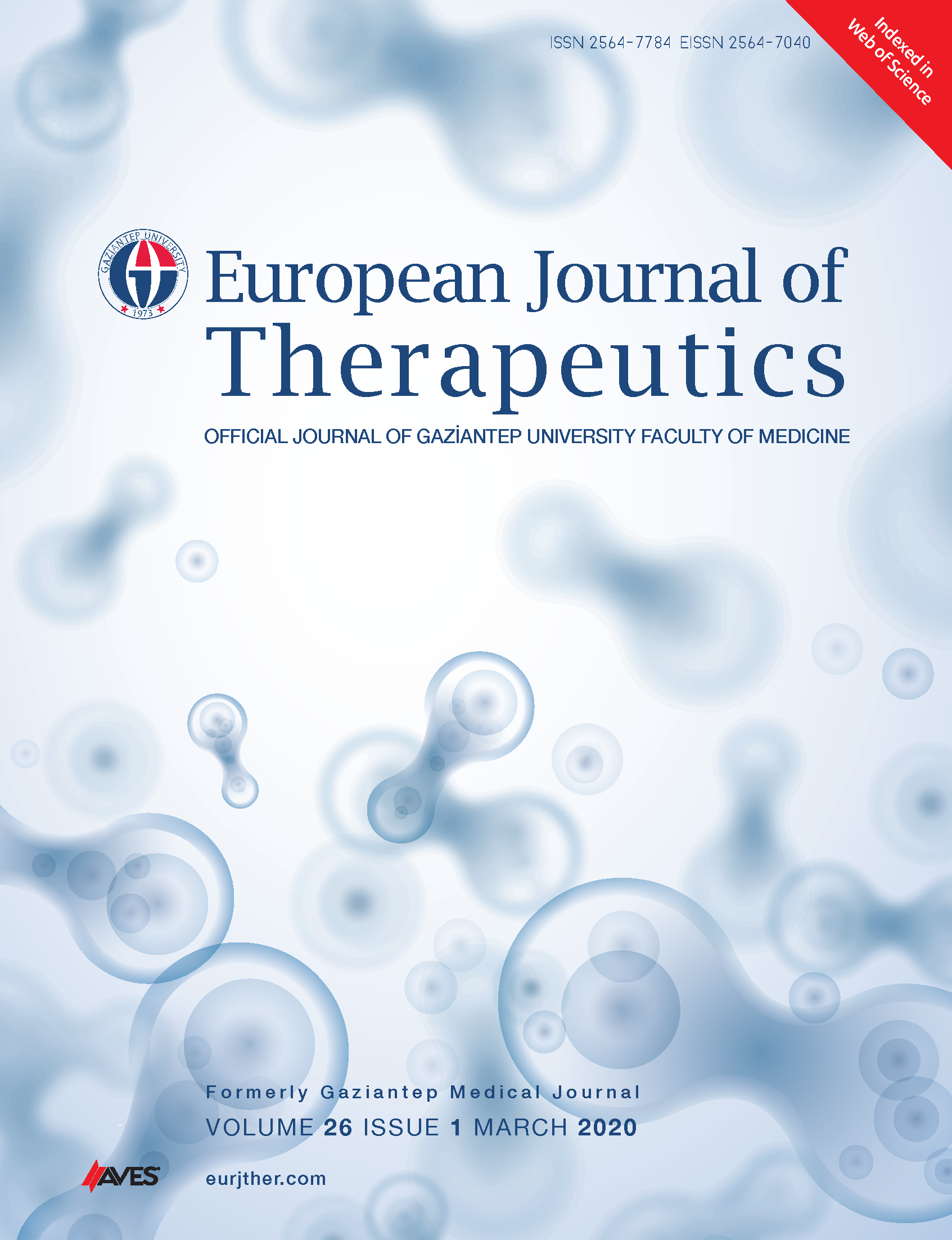Comparison of Incisional Hernias with Another Type of Abdominal Hernias in Terms of Predisposing Factors
Abstract
Objective: Incisional hernia (IH) is a common late complication of abdominal surgery. Factors such as wound infection, type of incision, wound closure technique, and suture material used and patient-related factors such as age, gender, body mass index (BMI), diabetes mellitus (DM), and smoking are also involved in the development of IH and other types of abdominal hernias (OTAH). In this article, we compared the predisposing factors for IH and OTAH in light of the literature.
Methods: Among 130 patients operated for abdominal hernia between January 2015 and December 2018 at the Department of General Surgery of GÜLHANE Training and Research Hospital, we analyzed the predisposing factors for IH and OTAH.
Results: The female-to-male ratio was 28:102, mean age was 58.6 years, and mean BMI was 29.3 kg. The prevalence of DM and smoking was also evaluated. The rate of drain application and hospitalization duration was 56.2% to 4.1% and 8.6–5.3 days in IH and OTAH groups, respectively.
Conclusion: We determined that male gender is a dominant risk factor for OTAH and high BMI for IH. Age, DM, and smoking are equivalent risk factors for both. Drain application for IH is highly statistically significant, which results in prolonged hospitalization. These results suggest an important complication of DM and obesity and conclude that obesity is a major risk factor for IH.
Note: Withdrawn
Metrics
References
Hope WW, Tuma F. Incisional Hernia. Treasure Island, FL: StatPearls Publishing Co; 2019
Nieuwenhuizen J, Eker HH, Timmermans L, Hop WCJ, Kleinrensink GJ, Jeekel J, et al. A double blind randomized controlled trial comparing primary suture closure with mesh augmented closure to reduce incisional hernia incidence. BMC Surg 2013; 28: 13-48.
Fink C, Baumann P, Wente MN, Knebel P, Bruckner T, Ulrich A, et al. Incisional hernia rate 3 years after midline laparotomy. Br J Surg 2014; 101: 51-4.
Henriksen NA, Helgstrand F, Vogt KC, Jorgensen LN, Bisgaard T, Database DN, et al. Risk factors for incisional hernia repair after aortic reconstructive surgery in a nationwide study. J Vasc Surg 2013; 57: 1524-30.
Winsnes A, Haapamaki MM, Gunnarsson U, Strigard K. Surgical outcome of mesh and suture repair in primary umbilical hernia: postoperative complications and recurrence. Hernia 2016; 20: 509-16.
Aquina CT, Rickles AS, Probst CP, Kelly KN, Deeb AP, Monson JRT, et al. Visceral obesity, not elevated BMI, is strongly associated with incisional hernia after colorectal surgery. Dis Colon Rectum 2015; 58: 220-7.
Lau B, Kim H, Haigh PI, Tejirian T. Obesity increases the odds of acquiring and incarcerating noninguinal abdominal wall hernias. Am Surg 2012; 78: 1118-21.
Kroese LF, Harlaar JJ, Ordrenneau C, Verhelst J, Guérin G, Turquier F, et al. The ‘AbdoMAN’: an artificial abdominal wall simulator for biomechanical studies on laparotomy closure techniques. Hernia 2017; 21: 783-91.
van Rooijen MMJ, Lange JF. Preventing incisional hernia: closing the midline laparotomy. Tech Coloproctol 2018; 22: 623-5.
Modena SF, Caldeira EJ, Peres MA, Andreollo NA. Influence of tobacco, alcohol and diabetes on the collagen of cremaster muscle in patients with inguinal hernias. Arq Bras Cir Dig 2016; 29: 218-22.
Hellspong G, Gunnarsson U, Dahlstrand U, Sandblom G. Diabetes as a risk factor in patients undergoing groin hernia surgery. Langenbecks Arch Surg 2017; 402: 219-25.
Burcharth J, Pommergaard HC, Bisgaard T, Rosenberg J. Patient-related risk factors for recurrence after inguinal hernia repair: a systematic review and meta-analysis of observational studies. Surg Innov 2015; 22: 303-17.
Shankar DA, Itani KMF, O’Brien WJ, Sanchez VM. Factors Associated With Long-term Outcomes of Umbilical Hernia Repair. JAMA Surg 2017; 152: 461-6.
Chang CM, Corey CG, Rostron BL, Apelberg BJ. Systematic review of cigar smoking and all cause and smoking related mortality. BMC Public Health 2015; 15: 390.
Henriksen NA, Mortensen JH, Sorensen LT, Bay-Jensen AC, Ågren MS, Jorgensen LN, et al. The collagen turnover profile is altered in patients with inguinal and incisional hernia. Surgery 2015; 157: 312- 21.
Mienaltowski MJ, Birk DE. Structure, physiology, and biochemistry of collagens. Adv Exp Med Biol 2014; 802: 5-29.
Goncalves Rde O, de Moraes e Silva E, Lopes Filho Gde J. Immunohistochemical evaluation of fibrillar components of the extracellular matrix of transversalis fascia and anterior abdominal rectus sheath in men with inguinal hernia. Rev Col Bras Cir 2014; 41: 23-9.
Henriksen NA. Systemic and local collagen turnover in hernia patients. Dan Med J 2016; 63: B5265.
Henriksen NA, Deerenberg EB, Venclauskas L, Fortelny RH, Miserez M, Muysoms FE. Meta-analysis on Materials and Techniques for Laparotomy Closure: The MATCH Review. World J Surg 2018; 42: 1666- 78.
Niggebrugge AH, Trimbos JB, Hermans J, Steup WH, Van De Velde CJ. Influence of abdominal-wound closure technique on complications after surgery: a randomised study. Lancet 1999; 353: 1563-7.
Cengiz Y, Blomquist P, Israelsson LA. Small tissue bites and wound strength: an experimental study. Arch Surg 2001; 136: 272-5.
Israelsson LA, Millbourn D. Closing midline abdominal incisions. Langenbecks Arch Surg 2012; 397: 1201-7.
Weiss E, McMlelland P, Krupp J, Karadsheh M, Brandy MS. Use of prolonged prophylactic antibiotics with closed suction drains in ventral abdominal hernia repair. Am Surg 2019; 85: 403-8.
Downloads
Published
How to Cite
Issue
Section
License
Copyright (c) 2023 European Journal of Therapeutics

This work is licensed under a Creative Commons Attribution-NonCommercial 4.0 International License.
The content of this journal is licensed under a Creative Commons Attribution-NonCommercial 4.0 International License.














